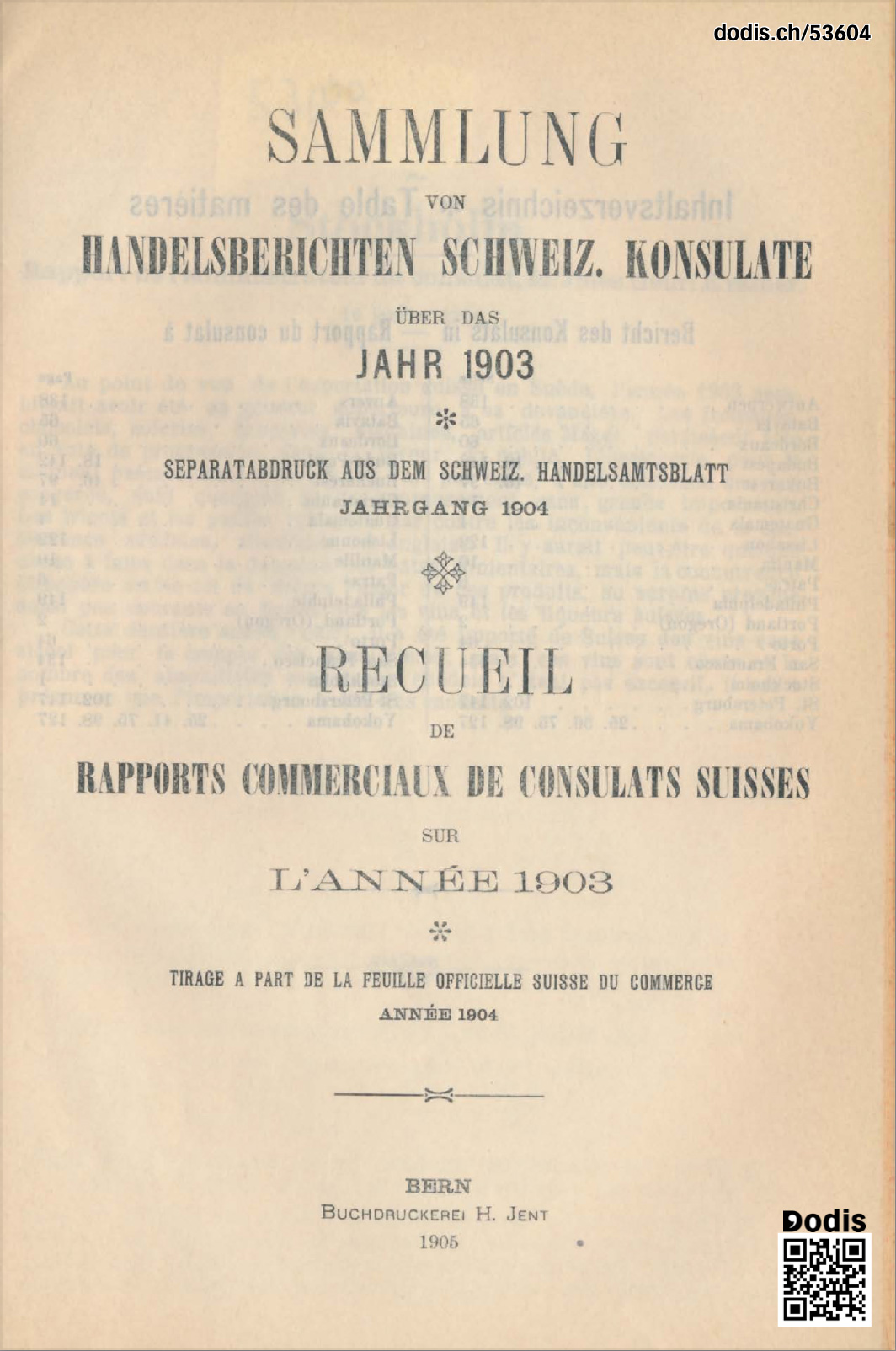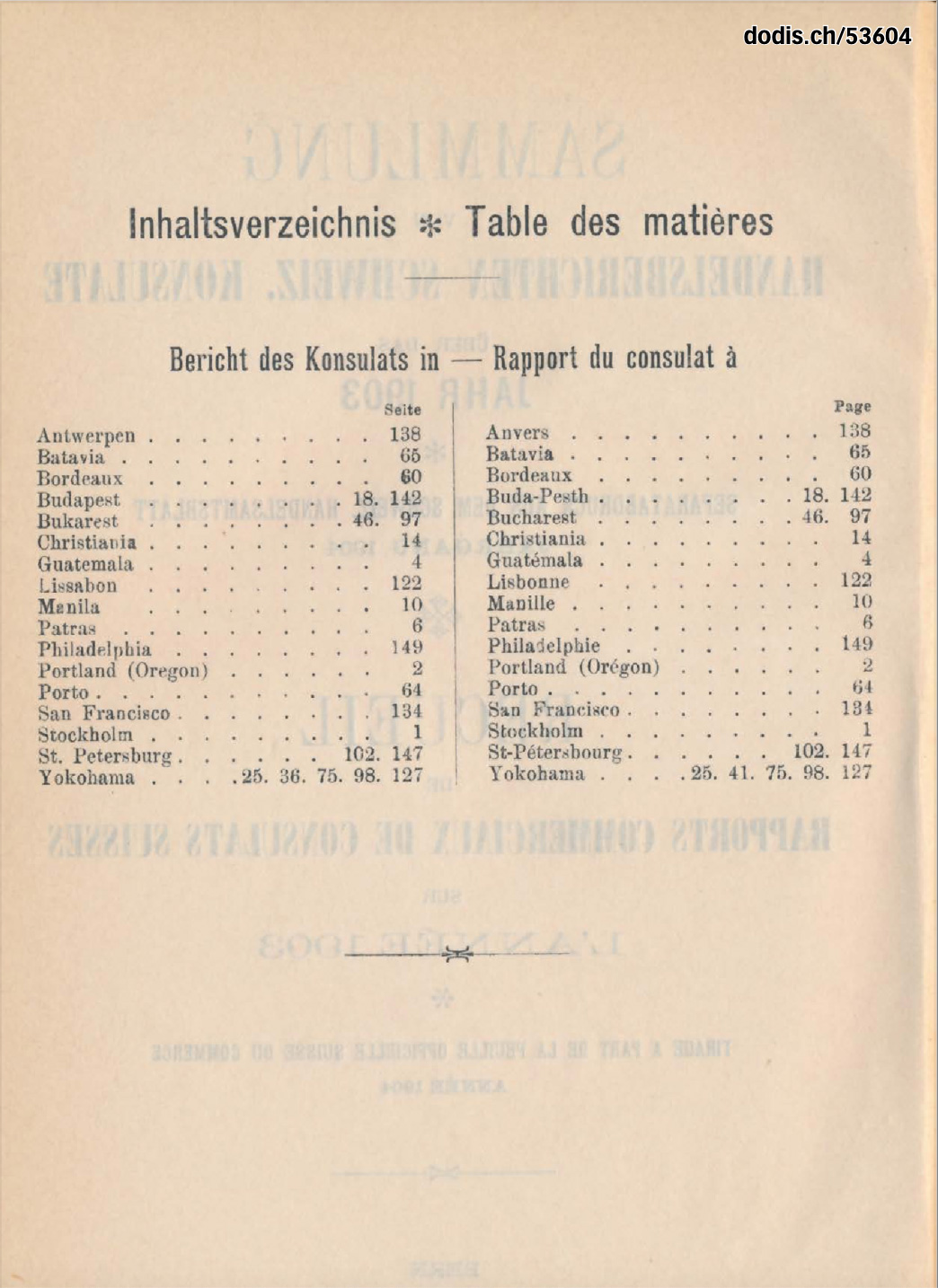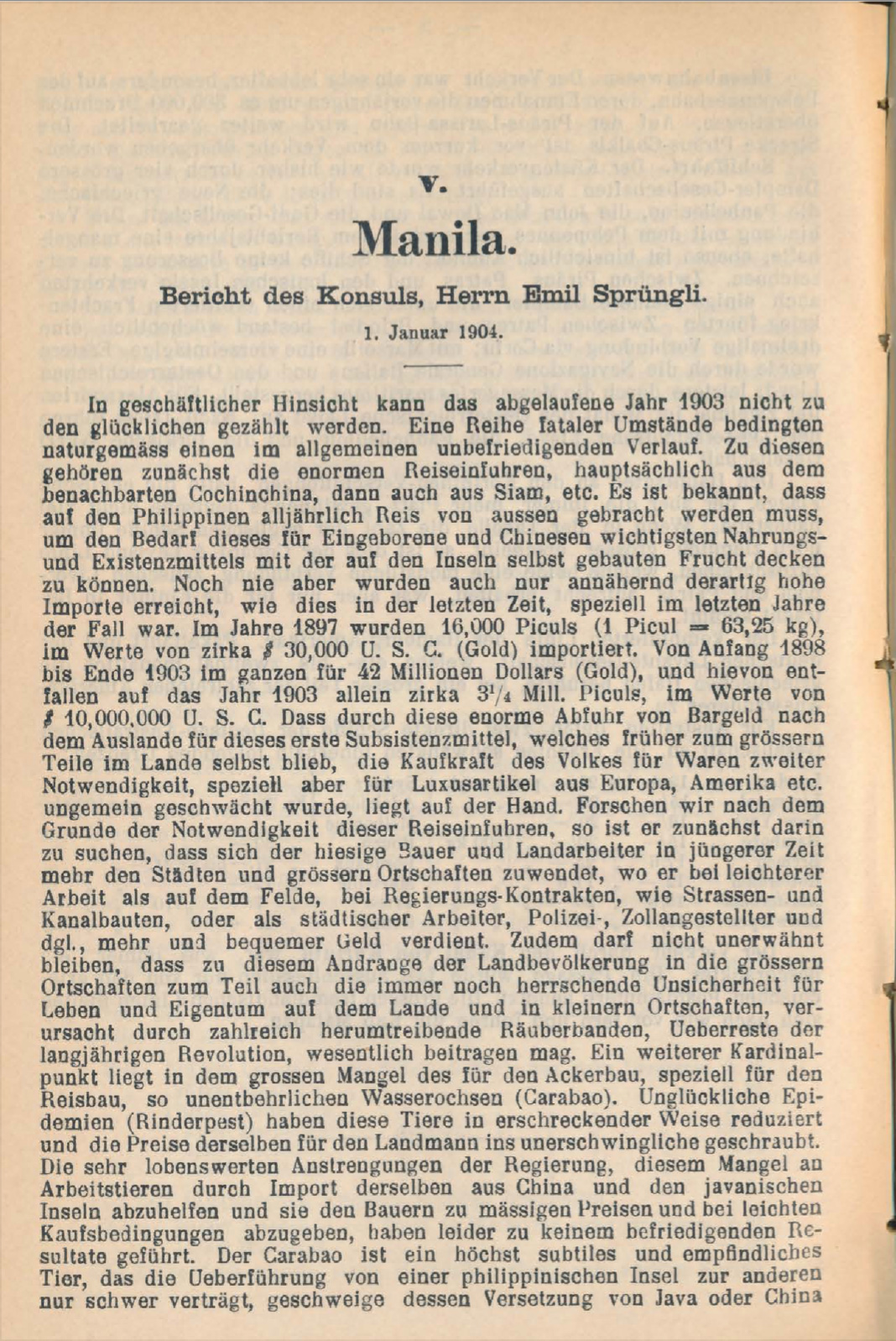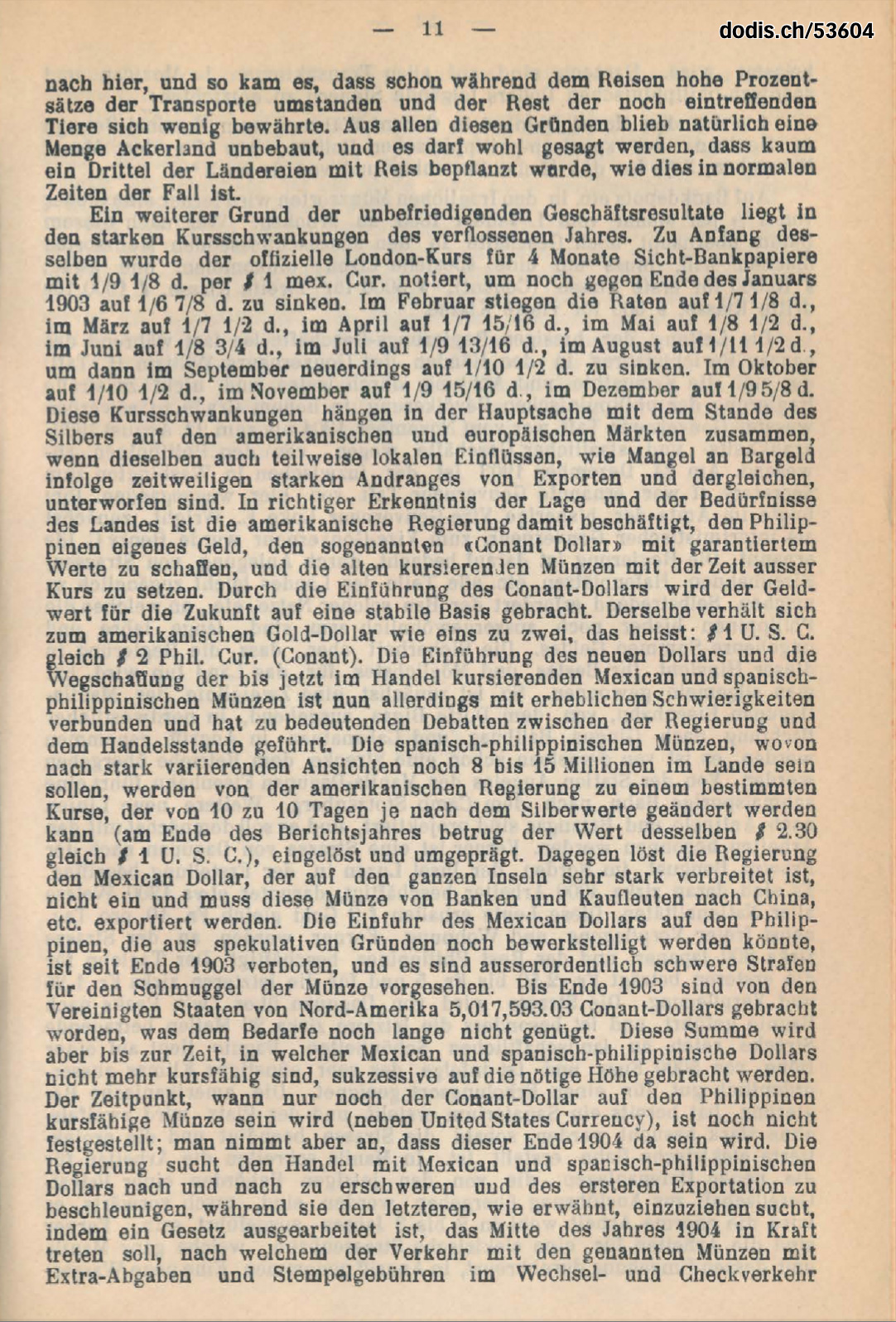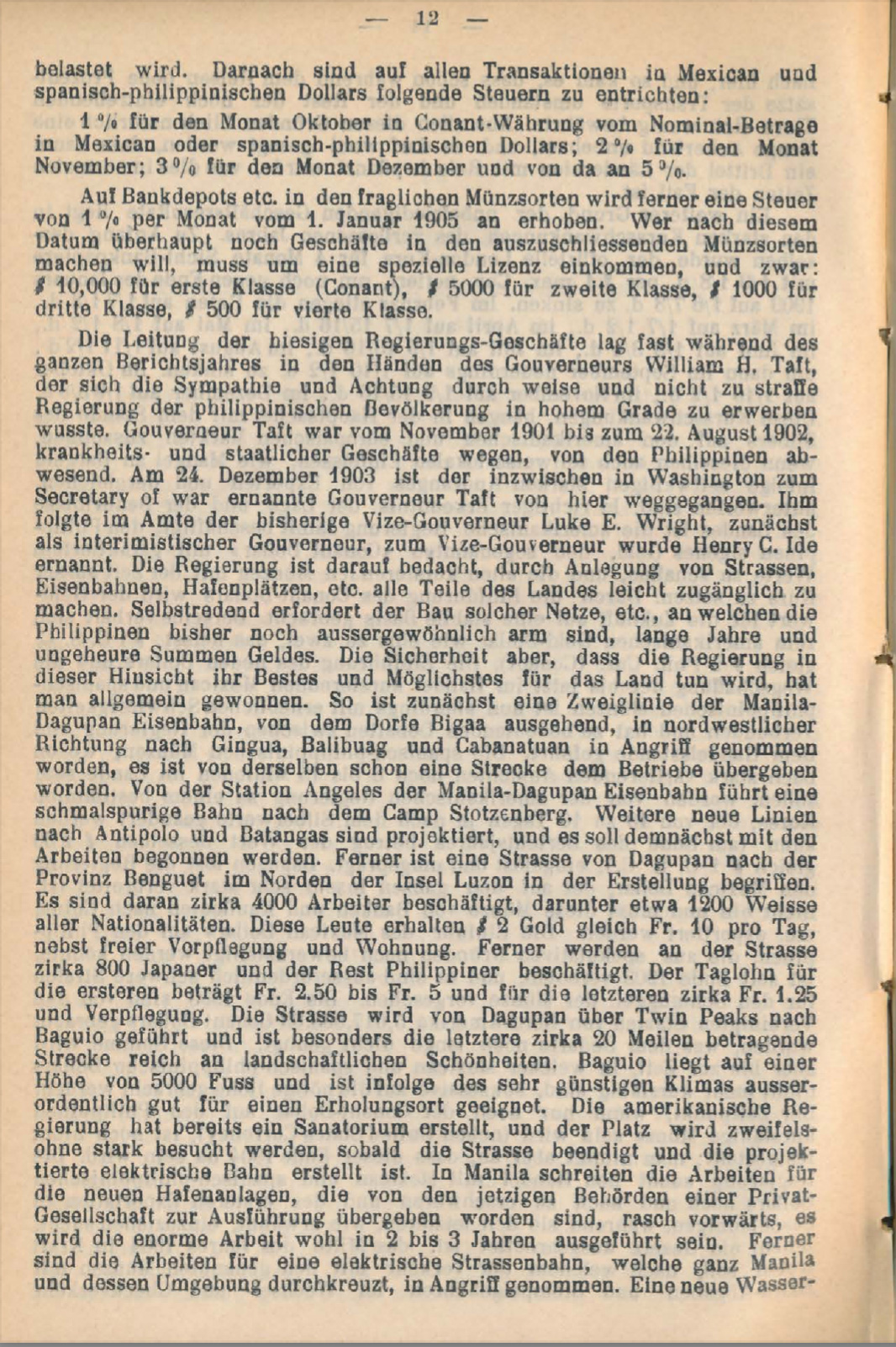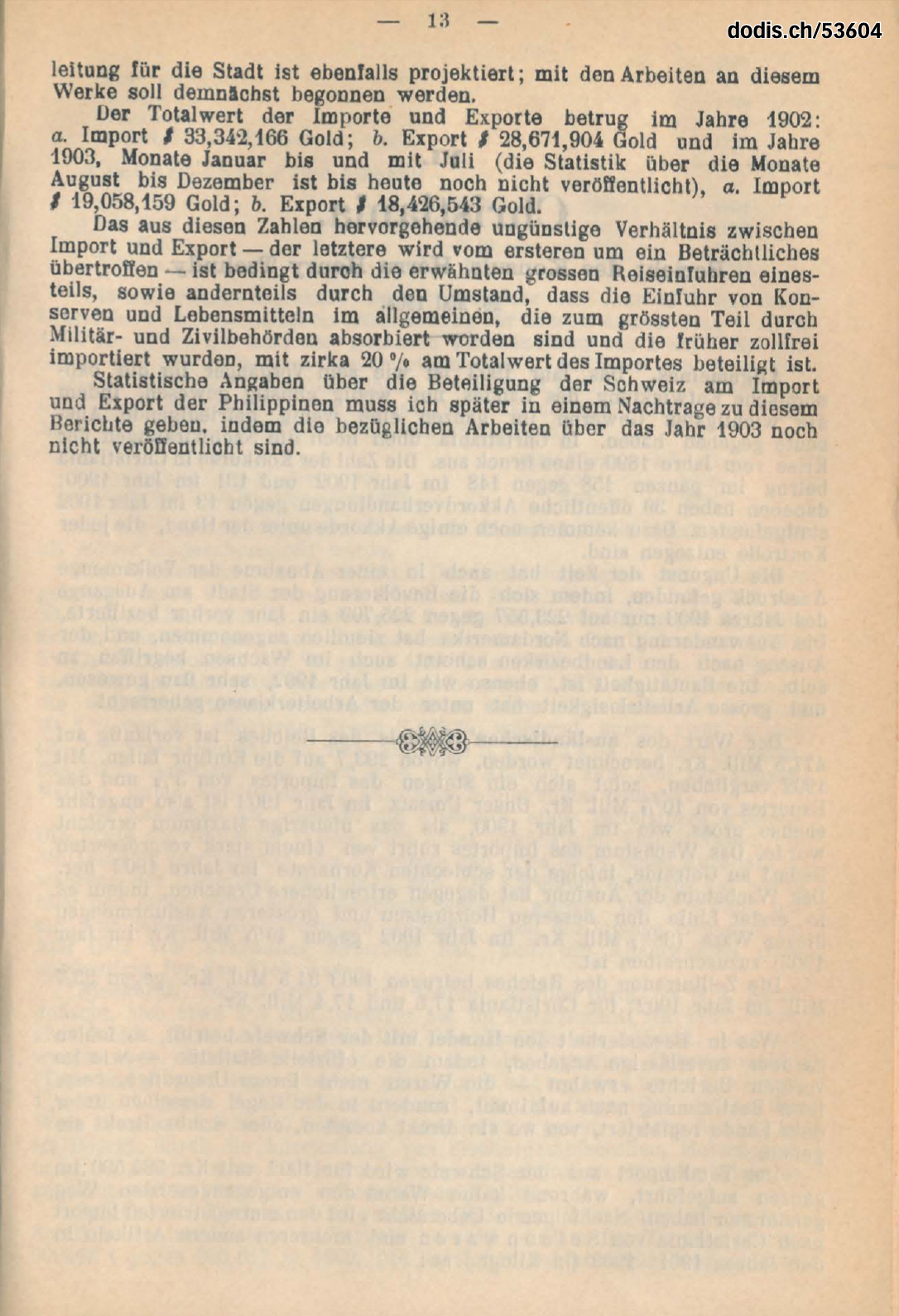Manila. Report of the Consul, Mr. Emil Sprüngli. January 1, 1904.
From the Trade Reports of the Swiss Consulates (1893–1904), Part V of the 1904 report is submitted by Sprüngli, Emil (1851–1910), the honorary Swiss consul to the Philippines from 1882–1910. The text has been translated from German by Stephanie Willi. Source: The Diplomatic Documents of Switzerland (Dodis) https://dodis.ch/P20525?lang=en
V.
Manila.
Report of the Consul, Mr. Emil Sprüngli.
January 1, 1904.
From a business point of view, the past year 1903 cannot be counted among the most fortunate of years. A series of fatal circumstances naturally resulted in a generally unsatisfactory course of business. Among these first of all, are the enormous rice imports, mainly from neighboring Cochinchina, then also from Siam, etc. It is well known that in the Philippines rice has to be brought in annually from outside, to meet the needs of this most important food and livelihood for the natives [Filipinos] and Chinese and the means of subsistence with the fruit [rice] grown on the islands themselves. However, never before have imports been as high as they have been in the past, especially in the last year. In 1897, 16,000 piculs (1 picul = 63.25 kg), in the value of ca. $ 30,000 U. S. C. (gold) were imported. From the beginning of 1898 until the end of 1903 a total of 42 million dollars (gold), and of which to the year 1903 alone about ¾ mill. piculs, in the value of $ 10,000,000 U. S. C. The fact that this enormous outflow of cash to foreign countries for this first means of subsistence, which used to remain mostly in the country itself, the purchasing power of the people for goods of second necessity, but especially for luxury articles from Europe, America, etc. was immensely weakened lies on the hand. If we investigate the reason for the necessity of these rice imports, it is to be sought first in the fact that in recent times the local farmer and agricultural workers turned more towards the cities and larger towns, where they can do lighter work than in the fields, comparing to government contracts, such as road and canal constructions, or as an urban worker, police officer, customs officer, etc., and earns more and more convenient money. Moreover, it should not be left unmentioned, that to this rush of the country population into the larger cities the still prevailing insecurity for life and property in the countryside and smaller villages, is caused by numerous roving bands of robbers, remnants of the long-standing revolution. Another cardinal point is the great scarcity of the essential water oxen (Carabow) for agriculture, especially for rice cultivation. Unfortunate epidemics (rinderpest) have reduced these animals in an alarming manner and the prices of the same for the country man into the unaffordable screwed. The very praiseworthy efforts of the government to compensate for this shortage of working animals by importing them from China and the Javanese islands and to provide them to the farmers at moderate prices and under easy conditions of purchase, have unfortunately not led to satisfactory results. The carabao is a highly subtle and sensitive animal that can not tolerate the transfer from one Philippine island to another let alone its transfer from Java or China
to here, and so it happened that already during the travel high percentages of the transports were overturned and the rest of the still arriving animals proved little. For all these reasons, of course, remained a lot of land was left uncultivated, and it is fair to say that hardly one-third of the land was planted with rice, as is the case in normal times.
A further reason for the unsatisfactory business results lies in the strong price fluctuations of the past year. At the beginning of the same the official London rate for 4 months of sight bank papers was quoted at 1/9 1/8 d. per $ 1 mex. Cur, in order to fall towards the end of January 1903 to 1/6 7/8 d. In February, rates rose to 1/7 1/8 d., in March to 1/7 1/2 d., in April to 1/7 15/16 d., in May to 1/8 1/2 d., in June to 1/8 3/4 d., in July to 1/9 13/16 d., in August to 1/11 1/2 d., then dropping again in September to 1/10 1/2 d. In October to 1/10 1/2 d., in November to 1/9 15/16 d., in December to 1/9 5/8 d.
These price fluctuations are mainly related to the state of the silver on the American and European markets, although they are also partly due to local influences, such as a shortage of cash as a result of a temporary rush of exports and the like, Correctly recognizing the situation and the needs of the country, the U.S. government is engaged in providing the Philippines with its own money, the so-called "Conant Dollar" with guaranteed value, and to put the old circulating coins with the time out of course. The introduction of the Conant dollar will put the value of money on a stable basis for the future. The same behaves to the American gold dollar as one to two, that is: $ 1 U. S. C. equals $ 2 Phil. Cur. (Conant). The introduction of the new dollar and the elimination of the Mexican and Spanish-Filipino coins that have been in circulation until now, however, is connected with considerable difficulties and has led to significant debates between the government and the merchant class. The Spanish-Filipino coins, of which according to widely varying opinions, 8 to 15 million are still in the country, will be redeemed and converted by the American government at a certain rate, which varies from 10 to 10 days, depending on the value of silver (at the end of the review year the value of the same was $ 2.30 equal to $ 1 U. S. C. ). On the other hand, the government does not redeem the Mexican dollar, which is widely used throughout the islands, and this coins must be exported by banks and merchants to China, etc. The importation of the Mexican Dollar in the Philippines, which could still be accomplished for speculative reasons, has been prohibited since the end of 1903, and extraordinarily severe penalties are provided for the smuggling of the coin. By the end of 1903, the 5,017,593.03 Conant dollars had been brought from the United States of North America, which is far from being sufficient to meet the demand. This sum will be successively brought up to the necessary level, when the Mexican and Spanish-Filipino dollars are no longer exchangeable.
The point in time when only the Conant dollar in the Philippines will be a negotiable coin (in addition to the United States Currency) has not yet been determined; however, it is assumed that this will be at the end of 1904. The government is seeking to gradually slowing down the trade with Mexican and Spanish-Filipino dollars, and to accelerate the exportation of the former, while it seeks to confiscate the latter, as mentioned above, by drawing up a law which is to come into force in the middle of 1904, under which the circulation of the said coins will be subject to extra duties and stamp duties on bills of exchange and checks
will be charged. Thereafter, on all transactions in Mexican and Spanish Philippine dollars shall be subject to the following taxes:
1 %, for the month of October in Conant currency from the nominal amount in Mexican or Spanish-Filipino dollars; 2 % for the month of November; 3 % for the month of December and from then on 5 %. On bank deposits etc., in the coins in question, there will be a tax of of 1 % per month from January 1, 1905. Who after this date wishes to do any business at all in the coins to be excluded must apply for a special license, namely: $ 10,000 for first grade (Conant), $ 5000 for second grade, $ 1000 for third class, $ 500 for fourth class.
The management of government business here was in the hands of the governor William H. Taft for most of the entire year, who has won the sympathy and esteem by wise and not too tight governing of the Philippine population. Governor Taft served from November 1901 to August 22, 1902, due to illness and government business, was absent from the Philippines. On December 24, 1903, the governor, Governor Taft departed from here. He was succeeded in office by the previous vice governor, Luke E. Wright, first as interim governor, and Henry C. Ide was then appointed to vice governor. The government is anxious to make all parts of the country easily accessible by laying out roads, railroads, harbors. Of course, the construction of such networks, etc., of which the Philippines is still exceptionally poor, requires long years and enormous sums of money. But the certainty that the government will do its best and possible for the country in this respect has been generally gained. Thus, to begin with, a branch line of the Manila Dagupan Railway, starting from the village of Bigaa, in a northwestern direction to Gingua, Balibuag and Capanatuan has been started, one section of this line has already been handed over for operation. From the Angeles station of the Manila-Dagupan Railway, a narrow-gauge railroad leads to Camp Stotzenberg. Other new lines to Antipolo and Batangas are planned, and work is to begin soon. Furthermore, a road from Dagupan to the Benguet Province in the north of Luzon Island is under construction. About 4000 workers are employed, among them about 1200 whites of all nationalities. These workers receive $ 2 gold equal to Fr. 10 per day, in addition to free boarding and lodging. Furthermore, on the road about 800 Japanese and the rest Filipinos are employed. The daily wage for for the former is Fr. 2.50 to Fr. 5 and for the latter about Fr. 1.25 including boarding. The road is led from Dagupan via Twin Peaks to Baguio and especially the latter part of about 20 miles is rich in scenic beauty. Baguio lies at an altitude of 5000 feet and due to its very favorable climate it is exceptionally well suited as a resort. The American government has already built a sanitarium, and the place will undoubtedly be heavily frequented as soon as the road is completed and the projected electric railroad is constructed. In Manila, work is progressing on the the new port facilities, which have been turned over by the present authorities to a private company for execution, rapidly, and the enormous work will probably be completed in 2 to 3 years. Furthermore the work for an electric tramway, which will crisscross the whole of Manila and its and its surroundings, has started A new
water pipeline for the city is also planned; work is expected to begin soon.
The total value of imports and exports in 1902 was:a. Import $ 33,342,166 gold; b. export $ 28,671,904 gold and in the year 1903, months January to and including July (the statistics for the months of August to December have not been published yet), a. import $ 19,058,159 gold; b. export $ 18,426,543 gold.
The unfavorable ratio between import and export - the latter being considerably outstripped by the former - is due, on the one hand because of the large imports of rice mentioned above, and on the other hand by the fact that the importation of canned goods and food products in general, which have been largely absorbed by the military and civil authorities, and which were formerly imported duty-free, is now responsible for about 20 % of the total value of imports.
Statistical data on Swiss participation in the import and export of the Philippines will have to be given later in a supplement to this report, as the relevant work on the year 1903 has not yet published.
Translated from German, May 2023, Stephanie Willi
